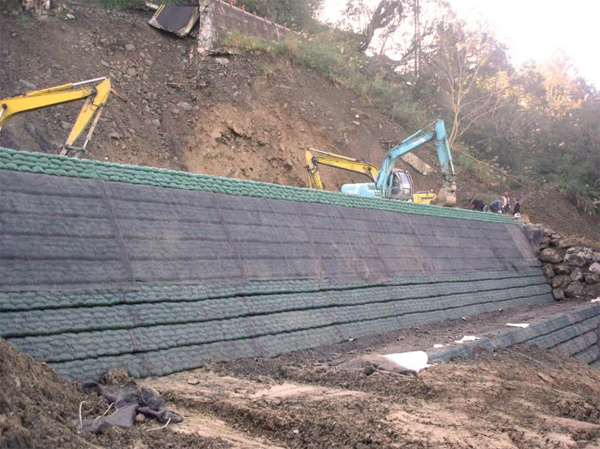
Our focus here is on low cost, owner-built homes. From time to time it’s interesting to explore related ideas to see what’s available or going on. As we’ve reported before, there’s a whole industry that specializes in industrial earthbag projects using geotextiles or geosynthetics. Their primary journal is called Geosynthetics Magazine.
As our regular readers know, earthbag building is growing rapidly. It’s time to take things to the next level to speed this building method into the mainstream. I just wrote Geosynthetics Magazine and asked if they could refer me to a geotextile engineer who is willing to design a standardized polypropylene gravel bag foundation or gravel tube foundation for mainstream home construction. The intent is to come up with an owner-builder friendly design as a substitute for concrete foundations.
If you’re a design professional, please search our related websites shown on the right side of the page. Be sure to check out our Testing page at Earthbag Building.com. That’s our main site with all the best projects, photos, videos, articles and more on every aspect of earthbag construction.
Image source: Geosynthetics Magazine
Related: Reinforced Soil Engineering

I love to see civil engineers confident to use earthbag. I’ll have to look through Geosynthetics and find out exactly what sort of soil in what climate with what finish surface they used.
Civil engineers know that earth in poly textiles can flex and make cheaper stronger walls than concrete. Now for architects to apply this.
Yes, it may take an engineer who specializes in this type of work to pave the way. We know it works. It just takes an expert in the field to get it code approved.
When you say foundations, are you referring to the floor? I don’t believe you’re talking about the walls. If you are talking about the floor slab then what would go on top of it? Correct me if I’ve got this all mixed up. You covered one time about using scoria and sand and then setting tile on top of that then, sweeping sand in between the cracks etc. to secure each tile. Is this what you had in mind? Forgive me if I’m way off base.
The foundation is the part under the wall. See our current code-approved earthbag specifications that use reinforced concrete. We’re looking to eliminate the concrete. https://naturalbuildingblog.siterubix.com/reinforced-earthbag-specifications/
Here are some previous blog posts about earthbag and gravel bag foundations:
Earthbag Foundations
https://naturalbuildingblog.siterubix.com/earthbag-foundations/
Earthbag/Stone Foundations
https://naturalbuildingblog.siterubix.com/earthbagstone-foundations/
Another Earthbag Foundation Method
https://naturalbuildingblog.siterubix.com/another-earthbag-foundation-method/
Seismic Resistant Gravel Bag Foundations
https://naturalbuildingblog.siterubix.com/seismic-resistant-gravel-bag-foundations/
Insulated Earthbag Foundations
http://www.instructables.com/id/Insulated-Earthbag-Foundations-for-Yurts/
Straw Bale Roundhouse in Taos, NM
https://naturalbuildingblog.siterubix.com/straw-bale-roundhouse-in-taos-nm/
The subject is also covered in detail in my Earthbag Building Guide and DVD: https://naturalbuildingblog.siterubix.com/owens-book-dvd/
Could you elaborate a little more on what your asking of this company? Thanks.
You can get code approval for rammed tire foundations, but I don’t know if gravel bag foundations have ever been approved (except in really lax areas). Kelly and I have been promoting gravel bag foundations for years and I would love to see a licensed engineer come up with an open source design everyone could use or learn from. This includes using regular gravel for most applications and porous lava rock for insulated foundations in cold climates.
Not only are earthbag/gravel bag foundations super low cost and simple to build, another key advantage is avoiding/minimizing the use of concrete for environmental reasons. Also, owner-builders may not have the skill to pour concrete foundations. Placing gravel bags is about as simple as it gets, and the work goes quite fast.
Geosynthetics Magazine is in contact with all the leading companies who work in the field and so maybe they’ll know someone who can help. It’s worth a try. If they can design million dollar industrial projects, think how easy it would be to come up with a generic house foundation.